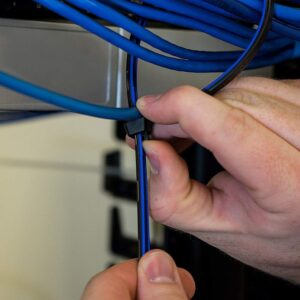GUIDE
Unraveling the Wonders of Cable Ties: A Comprehensive Guide
In the vast landscape of tools and accessories, there’s one humble yet indispensable item that often goes unnoticed – the cable tie. Also known as zip ties or wire ties, these simple fasteners have become an integral part of our daily lives, playing a crucial role in organizing and securing cables, wires, and more. In this comprehensive guide, we’ll dive deep into the world of cable ties, exploring their uses, types, and the importance of choosing the right ones for different applications.
The Basics of Cable Ties
What are Cable Ties?

Cable ties are flexible fasteners designed for bundling and organizing items, primarily cables and wires. They consist of a tape section with teeth that engage with a pawl in the head to form a ratchet so that as the free end of the tape section is pulled, the cable tie tightens. Once secured, it becomes challenging to release the tie without cutting it.
Materials Used in Cable Ties
Cable ties are typically made from various materials, each chosen for specific purposes:
– Nylon Cable Ties: These are the most common and versatile. They are suitable for both indoor and outdoor use, as nylon is resistant to various environmental factors like UV rays and extreme temperatures.
– Stainless Steel Cable Ties: Ideal for heavy-duty applications, stainless steel cable ties offer exceptional strength and durability. They are resistant to corrosion and can withstand harsh conditions.
– Velcro Cable Ties: Unlike traditional cable ties, Velcro ties are reusable. They are excellent for managing cables that may need frequent adjustments.
The Many Applications of Cable Ties
1. Cable Management in Home and Office:
One of the most common uses of cable ties is in cable management. In both home and office environments, cables from electronic devices such as computers, routers, and entertainment systems can quickly become a tangled mess. Cable ties provide a simple yet effective solution for organizing and securing these cables, creating a neater and more efficient workspace.
2. Automotive Applications:
In the automotive industry, cable ties are extensively used for securing wiring harnesses and managing cables in vehicles. Their ability to withstand vibrations and exposure to different weather conditions makes them invaluable in this context.
3. Construction and DIY Projects:
Cable ties find their way into various construction and do-it-yourself (DIY) projects. From securing temporary fencing to bundling together construction materials, cable ties offer a quick and reliable solution.
4. Gardening and Landscaping:
In outdoor settings, cable ties are employed for gardening and landscaping purposes. They can be used to support plants, tie together branches, or even create makeshift trellises. Their weather-resistant properties make them suitable for enduring outdoor conditions.
5. Emergency Repairs:
Cable ties are often referred to as the “handyman’s secret weapon.” In emergency situations, they can serve as makeshift fixes for broken items, from temporarily patching up a backpack strap to securing a loose bumper on a car.
Different Types of Cable Ties

1. Standard Cable Ties:
The most common type, standard cable ties are suitable for a wide range of applications. They come in various lengths and colors, allowing users to choose the right tie for their specific needs.
2. Releasable Cable Ties:
Unlike standard ties, releasable cable ties can be undone and reused. This makes them an excellent choice for situations where adjustments may be necessary.
3. Heavy-Duty Cable Ties:
Designed for robust applications, heavy-duty cable ties are thicker and stronger. They are commonly used in construction, automotive, and industrial settings where greater tensile strength is required.
4. Colored Cable Ties:
Colored cable ties are often used for color-coding purposes, making it easy to identify different cable bundles or groups. This is particularly useful in complex wiring setups.
5. Mounting Cable Ties:
Equipped with an integrated mounting hole, these ties allow users to secure cables to surfaces. This is especially handy in situations where drilling holes for separate mounts may not be feasible.
Choosing the Right Cable Ties for Your Needs
Selecting the right cable ties depends on the specific requirements of your application. Here are some factors to consider:
1. Tensile Strength:
Different cable ties have varying tensile strengths. For lighter applications like home cable management, standard ties may suffice. For heavier loads, opt for heavy-duty or stainless steel cable ties.
2. Environment:
Consider the environmental conditions the cable ties will be exposed to. If they’ll be outdoors, exposed to sunlight or extreme temperatures, choose UV-resistant and weatherproof options.
3. Reusability:
For applications where adjustments might be necessary, such as in temporary setups or installations, opt for releasable or Velcro cable ties.
4. Size and Length:
Choose the right size and length of cable ties for your specific needs. Too short, and they may not wrap around larger bundles; too long, and they may be cumbersome for smaller applications.
Tips for Using Cable Ties Effectively
1. Bundle Cables Neatly:
Keep cables organized by bundling them neatly with cable ties. This not only enhances the aesthetics but also makes it easier to identify and trace specific cables when needed.
2. Use Colored Ties for Identification:
Employ colored cable ties for color-coding different cable bundles. This is particularly helpful in complex setups with numerous cables.
3. Avoid Over-tightening:
While cable ties are designed to be secure, avoid over-tightening, especially around delicate cables. Over-tightening can damage the insulation and affect the performance of the cables.
4. Consider Reusability:
If you anticipate making changes to your cable setup, consider using releasable or Velcro cable ties for easier adjustments.
5. Check Tensile Strength:
Always check the tensile strength of the cable ties to ensure they can handle the load or weight they’ll be securing.
Conclusion
In the world of organization and efficiency, cable ties stand out as unsung heroes, silently working to keep our spaces neat and functional. From the tangle of cables behind our entertainment centers to the intricate wiring in industrial settings, cable ties play a crucial role in maintaining order. Understanding the different types, applications, and considerations when choosing cable ties empowers users to make informed decisions, ensuring that these simple yet effective fasteners serve their purpose effectively.
So, the next time you find yourself in need of securing, organizing, or simply tidying up, reach for the humble cable tie – a versatile tool that continues to weave its way into the fabric of our daily lives.

-

 EDUCATION3 months ago
EDUCATION3 months agoFree Cover Letter Generator: Build Job-Winning Letters in Minutes
-

 GUIDE3 months ago
GUIDE3 months agoBenefits of Online Personal Training for Fitness Success
-

 BUSINESS2 months ago
BUSINESS2 months agoGrow Your Audience with USA Instagram Followers
-

 TECH2 months ago
TECH2 months agoFreedom Forever Solar Reviews Explain How Conversational Intelligence Turns Customer Interactions into Insights